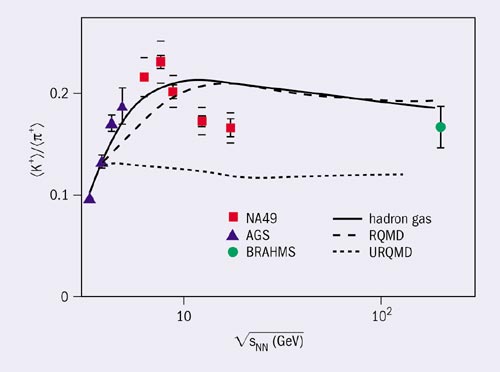Recent results and future experiments were the topics in a workshop to look into exactly what happens as strongly interacting matter becomes deconfined.
“Tracing the onset of deconfinement in nucleus-nucleus collisions” was the name of a workshop held at the European Center for Theoretical Studies in Nuclear Physics and Related Areas (ECT*) in Trento, Italy, on 24-29 April. Around 40 theorists and experimentalists from Europe, Japan and the US came together to discuss recent progress in the study of the energy dependence of particle production in nuclear collisions. The workshop focused on a prominent issue in high-energy nuclear physics: whether anomalies measured for central lead-lead collisions at low energies at CERN’s Super Proton Synchrotron (SPS) signal a phase transition from confined to deconfined strongly interacting matter.

Mark Gorenstein of Kiev began the workshop by recalling the basic ideas that motivated the energy scan programme at the SPS and comparing the old predictions with recent data from the SPS and from the Alternating Gradient Synchrotron (AGS) and the Relativistic Heavy Ion Collider (RHIC) at the Brookhaven National Laboratory. (Last year the NA49 collaboration presented numerous results on collisions at the five energies – 20, 30, 40, 80 and 158 AGeV – of the energy scan programme at the SPS.) Gorenstein pointed out that the unusual energy dependence of hadron production expected in the case of the onset of deconfinement is in fact observed.
This introductory talk was followed by experimental reviews of the most recent results from SIS, the heavy-ion synchrotron at GSI, Darmstadt, as well as from the AGS, SPS and RHIC. These presentations focused on the energy dependence of a number of observables. In particular, Marco van Leeuwen of the Lawrence Berkeley National Laboratory discussed data on strange hadron yields and concluded that the relative strangeness production shows a sharp maximum (the “horn”) at about 30 AGeV. Results on the change in the energy dependence of pion multiplicity (the “kink”) and the anomaly in the shape of transverse mass spectra (the “step”) were also reported. Finally, the results were compared with the latest predictions of the hadron gas model and microscopic string-hadronic models (RQMD and URQMD) of the collision process. Neither model is able to reproduce adequately the observed anomalies, as figure 1 indicates.
Several speakers explored new phenomena related to the onset of deconfinement. Fluctuations were the focus of this discussion. Large deviations from purely statistical behaviour are expected when the trajectory on the phase diagram of the expanding and cooling matter passes close to the hypothetical critical point. Models predict that this point may be located in the region accessible in nuclear collisions at SPS energies (see figure 2).
The view on properties of the quark-gluon plasma (QGP) at T = (1-2) Tc, where Tc is the phase transition temperature, has recently radically changed. Instead of being regarded as a weakly interacting gas of quasiparticles, the QGP is now viewed as a near-perfect liquid. The lattice QCD results show that charmonia states (of a charm quark and antiquark) remain bound at such temperatures, contrary to the previous belief. Edward Shuryak of Stony Brook argued that similar bound states should exist for light quarks and gluons, in particular correlated coloured pairs of light quarks may be present. Andrei Starinets from Seattle demonstrated that the transition from weakly to strongly coupled QGP can be theoretically studied in an N = 4 supersymmetric Yang-Mills theory using Juan Maldacena’s conjecture of duality between gauge theories and string theories. The strongly coupled QGP explains the validity of a hydrodynamical description of matter flow and predicts a (surprisingly small) value for its viscosity.

The workshop closed with a review of new experimental projects, which in future may extend the studies begun by the energy scan programme at the SPS at CERN. Christoph Blume from Frankfurt reported on the proposal to extend the SPS programme to study the collisions of light ions and protons in the energy range 10-160 AGeV. The new experiment would be based on the upgraded NA49 detector. This programme, if approved, may start in 2006 and run in parallel to the Large Hadron Collider. It should result in a unique measurement of the two-dimensional (energy-system-size) dependence of hadron production that is necessary for a precise understanding of the onset effects observed in central lead-lead collisions, and for a search of the critical phenomena.
Ideas for the study of nuclear collisions in a fixed-target experiment at RHIC (energy 10-100 AGeV) were discussed by David Hofman of Chicago. This experiment could be based on the existing BRAHMS detector and would take data in parallel to the collider experiments at RHIC. Several options for the target are under discussion: a foil or wire target in the beam halo, a gas jet and a low-energy “crossing” ion beam. The unique feature of this project would be an almost continuous measurement of the energy dependence of inclusive hadron production while the RHIC beams are ramped to full energy.
Finally, Volker Friese of GSI presented the current status of the new experimental facility, FAIR, at GSI. The Condensed Baryonic Matter (CBM) experiment is being designed to study lead-lead collisions at energies of 2-35 AGeV with very high intensity beams. The properties of dense hadronic matter will be the focus of the study, and the first data taking is scheduled for 2012.
Overall, the workshop indicated the large theoretical and experimental interest in the study of nuclear collisions in the low SPS energy range, where a number of phenomena have been observed that could be related to the onset of deconfinement. This has motivated the idea of establishing an annual series of workshops on this matter.







